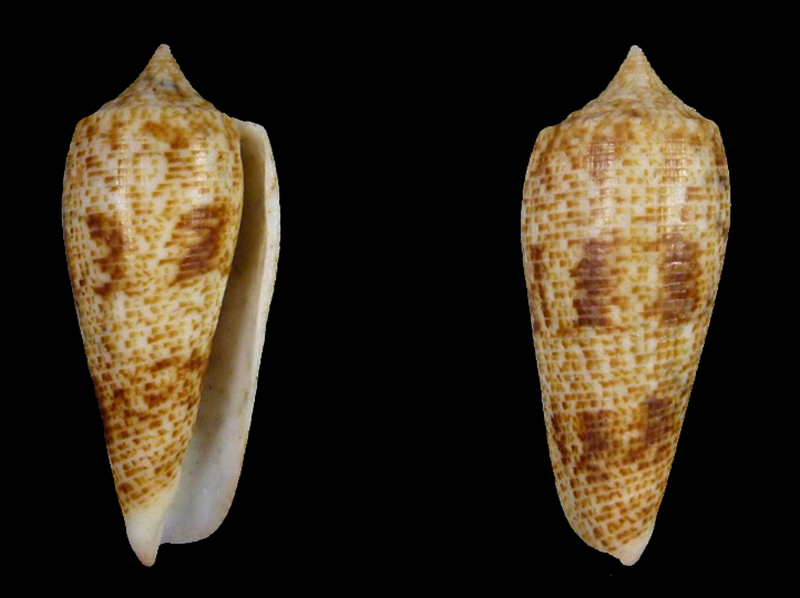 Christophe ROUXAssidu
Christophe ROUXAssidu
- Messages : 1407
Date d'inscription : 18/01/2011
Age : 63
Localisation : Vitry sur Seine (94)
 Conus (Phasmoconus) patamakanthini Delsaerdt, 1998
Conus (Phasmoconus) patamakanthini Delsaerdt, 1998
Mer 18 Sep 2013 - 18:43
Conus (Phasmoconus) patamakanthini Delsaerdt, 1998
Une trouvaille très rare à Ottmarsheim...
Il en existe extrêmement peu dans le monde.
Collecté mort mais ... il me faudra économiser et attendre si j'en veux un trouvé vivant !
Appartient probablement au genre Nimboconus... c'est visiblement le grand frère de N. nimbosus Hwass in Bruguière, J.G., 1792
Evidement le WoRMS est une fois de plus à côté de la plaque, il le place comme Conus gracilis Sowerby I, 1823 lui même synonyme de Conus australis Holten, 1802...
Conus patamakanthini (Nimboconus) (Delsaerdt, 1998)
Thaïlande 77,9 mm

_________________
Servir d'abord
 Rhum3389Assidu
Rhum3389Assidu
- Messages : 4235
Date d'inscription : 27/01/2011
Age : 74
Localisation : 33133
 Re: Conus (Phasmoconus) patamakanthini Delsaerdt, 1998
Re: Conus (Phasmoconus) patamakanthini Delsaerdt, 1998
Mer 18 Sep 2013 - 19:11
joli cône Chistophe
Qu'est ce qui en fait la caractéristique?
bernard
Qu'est ce qui en fait la caractéristique?
bernard
 Christophe ROUXAssidu
Christophe ROUXAssidu
- Messages : 1407
Date d'inscription : 18/01/2011
Age : 63
Localisation : Vitry sur Seine (94)
 Re: Conus (Phasmoconus) patamakanthini Delsaerdt, 1998
Re: Conus (Phasmoconus) patamakanthini Delsaerdt, 1998
Jeu 19 Sep 2013 - 9:16
Cette espèce est rare dans les collections et on ne connait quasiment rien de son écologie et régime alimentaire. La plupart ont été dragués par 100-120 m du côté de Rasha Island en Thaïlande.
Au premier abord il ressemble à P. australis de Thaïlande (en cours de description).
Cependant lorsqu'on met côte à côte P. patamakanthini et P. australis de Thaïlande, les différences sont évidentes: australis de Thailande est plus étroit et les dessins et les sculptures sont beaucoup plus proches de nimbosus.
Description:-Source Original description
General shape narrowly conoid-cylindrical. Spire of moderate height, slightly concave; shoulder angulate. The elongated last whorl encircled with about 40 flat ribbons on which brown, axial, short streaks. This pattern is overlaid with irregular, brown blotches grouped in two broad, interrupted spiral bands and in a smaller band near the shoulder. Teleoconch sutural ramps with 3-4 spiral grooves, axially and finely striated. Pattern of the spire axially veined.
Discussion:-C. australis differs from the new species by the tuberculate postnuclear whorls; the more numerous spiral grooves on the spire whorls; the pattern of irregular blotches on the spire (only veined in the new species) ; the form of ribs on the last whorl; the axial sculpture of the grooves between these ribs; and its outline (in the new species the last whorl is more swollen below the shoulder).
C. gabryae also have tuberculate postnuclear whorls; the ribs on the last whorl are duplicated and often granulose; sometimes an axial sculpture of the grooves (as in C. australis); the bodywhorl being more ventricose, even ovate.
Au premier abord il ressemble à P. australis de Thaïlande (en cours de description).
Cependant lorsqu'on met côte à côte P. patamakanthini et P. australis de Thaïlande, les différences sont évidentes: australis de Thailande est plus étroit et les dessins et les sculptures sont beaucoup plus proches de nimbosus.
Description:-Source Original description
General shape narrowly conoid-cylindrical. Spire of moderate height, slightly concave; shoulder angulate. The elongated last whorl encircled with about 40 flat ribbons on which brown, axial, short streaks. This pattern is overlaid with irregular, brown blotches grouped in two broad, interrupted spiral bands and in a smaller band near the shoulder. Teleoconch sutural ramps with 3-4 spiral grooves, axially and finely striated. Pattern of the spire axially veined.
Discussion:-C. australis differs from the new species by the tuberculate postnuclear whorls; the more numerous spiral grooves on the spire whorls; the pattern of irregular blotches on the spire (only veined in the new species) ; the form of ribs on the last whorl; the axial sculpture of the grooves between these ribs; and its outline (in the new species the last whorl is more swollen below the shoulder).
C. gabryae also have tuberculate postnuclear whorls; the ribs on the last whorl are duplicated and often granulose; sometimes an axial sculpture of the grooves (as in C. australis); the bodywhorl being more ventricose, even ovate.
_________________
Servir d'abord
 Boutillier MichelAssidu
Boutillier MichelAssidu
- Messages : 3336
Date d'inscription : 05/01/2013
Age : 76
Localisation : J'habite en Haute-Savoie.
 Re: Conus (Phasmoconus) patamakanthini Delsaerdt, 1998
Re: Conus (Phasmoconus) patamakanthini Delsaerdt, 1998
Jeu 19 Sep 2013 - 11:43
Jolie coquille même trouvée morte ,alors vivante ....... Merci Christophe pour ces explications .
Michel
Michel
 Rhum3389Assidu
Rhum3389Assidu
- Messages : 4235
Date d'inscription : 27/01/2011
Age : 74
Localisation : 33133
 Re: Conus (Phasmoconus) patamakanthini Delsaerdt, 1998
Re: Conus (Phasmoconus) patamakanthini Delsaerdt, 1998
Jeu 19 Sep 2013 - 17:50
Merci Christophe pour ces données scientifiques
bernard
bernard
- Conus (Phasmoconus) solomonensis Delsaerdt, 1992
- Conus (Phasmoconus) lovellireevei Raybaudi, 1993 voir Conus (Phasmoconus) asiaticus lovellreevei
- Conus (Phasmoconus) merleti (Mayissian, 1974) voir Conus (Phasmoconus) moluccensis
- Conus (Phasmoconus) colorovariegatus Kosuge, 1981 voir Conus (Phasmoconus) neptunus
- Conus (Phasmoconus) filamentosus (Reeve, 1849) voir Conus (Ph) conspursus
Permission de ce forum:
Vous ne pouvez pas répondre aux sujets dans ce forum

